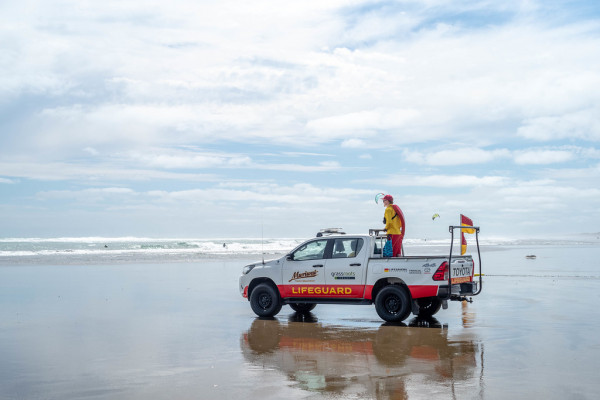Saving lives with signage
Standards can help save lives. That’s a fact Dr Mick Kearney, National Coastal Safety Manager with Surf Life Saving New Zealand, believes. He is on a mission to bring standardisation to water signage across New Zealand.

Credit: Tom Coates/CC BY-NC 2.0
Already in the ten years leading up to 2020, a massive 360 lives were lost across New Zealand, where the 10-year average beach and coastal fatal downing rate is 48% higher than the Australian average and on the rise.
‘Each fatal drowning is a tragedy in its own right,’ says Mick. ‘It affects not only the close family and friends but wider communities and the emergency services. The biggest tragedy is that the majority of these are preventable.’
Standardised signs support concerted efforts
For Surf Life Saving New Zealand rescues are just a part of their concerted efforts to save lives. ‘Rescues are the ambulance at the bottom of the cliff. Preventing an incident occurring begins with education and clear information.’
‘Fatalities are just the tip of the iceberg. For every loss of life to drowning there could be another 10 hospitalisations including coastal related incidents such as falls or boating incidents. Behind that there could be 20 rescues that successfully save lives. None of these are counted in consistent reports from across agencies. Then beyond these there are the unreported rescues or lives saved from people choosing to act differently due to clear signage.’
And signage is where standardisation is key.
‘Currently regions and different councils operate independently. Now a sign may seem like a passive instrument in saving lives but they do make a difference as mitigating actions collectively with training and capability. Standardisation could be integrated into the curriculum so there is a consistent story across the country.’
‘Signage can save lives without having to build capability – that ambulance at the bottom of the cliff - and if people do not know of the dangers in a specific area, or understand what the sign is telling them, then there is a real risk. Signs effectively save lives ‘outside of the flags’ as we put it, as Surf Life Saving New Zealand which relies heavily on volunteers only during summer months, cannot patrol every part of New Zealand’s vast coastline and internal water bodies.’
‘Travelling New Zealand, I’ve seen signs on flimsy wooden posts that wouldn’t last a day in Wellington winds. I’ve seen white signs, yellow signs, blue signs in all shapes and sizes. I’ve even seen green safety signs designed to ‘blend’ with the natural environment. I’ve seen signs that advise ‘no dog walking’ that are more prominent than safety signs that save lives’. Frustration is evident in Mick’s voice. ‘I’ve seen signs that simply say ‘take care swimming’…. What does that even mean, to take care?’ Mick muses.
‘Wherever there is a body of water, from the Waimakariri river, and shores of Taupo, to marine reserves like Goat Island or coastal camp grounds and swimming pools, there needs to be the right, formal signage.’
Don’t reinvent the wheel
‘Consistency means we aren’t reinventing the wheel. With training supported by consistent messaging and content people can learn to recognise the signs and what they mean. Signs will be built to last and stand out in the right places. Inconsistency weakens the authority of a sign.’
‘The standard already exists for councils and agencies responsible for water bodies to use. AS/NZS 2416.3:2010: Water safety signs and beach safety flags - Guidance for use is consensus built so that multiple views were considered in the development. There will also be consistencies with Australia too to support international visitors using New Zealand’s waterways. The standard provides guidance on design and location, mounting positions, lighting and maintenance and even location when used with multiple signs.’
‘New Zealand has distinct cultural needs and use of water including rahui. I’d like to see future iterations of the standard incorporate good practice on integrating these considerations so that the standard can work even better for Kiwi’s needs.’
‘We need to get everyone using this standard and integrated into council strategies. Standards fill the gap in knowledge, they support agencies to work consistently whether that’s Department of Conservation or councils or others. New Zealanders want consistency and the confidence that comes from standards underpinning decision-making.’
Consistent messages to the public
‘We can save lives without having to build life-saving capacity through simple, consistent and effective water safety preventions. It’s really quite straight forward, increased and effective signage means reduced incidents. Us Kiwis love water. We need to ask ourselves how many people went home safely because they didn’t walk too close to a cliff, they didn’t surf and swim near those rip tides, they didn’t take their boat near submerged rocks, because of clear signage. We should do everything in our powers to make sure there are no more tragic losses of life in New Zealand’s waterways.’
Mick is advocating across New Zealand, with councils, Department of Conservation and other agencies responsible for water ways, to only use water safety signage developed in line with the ISO, so that our message to the public is consistent and can be used with confidence.
If you are an influencer, policy maker or decision maker responsible for water bodies and community safety, then consider AS/NZS 2416.3:2010: Water safety signs and beach safety flags - Guidance for use to inform your strategic plans. Talk to us at Standards New Zealand about the many standards that can show good practice to your community.
